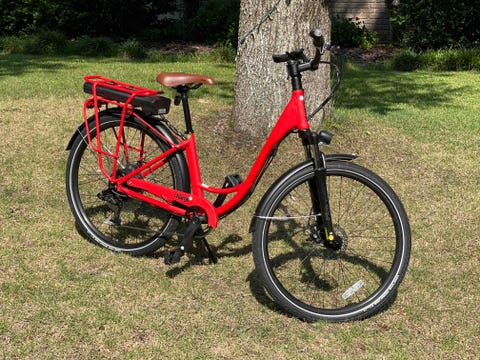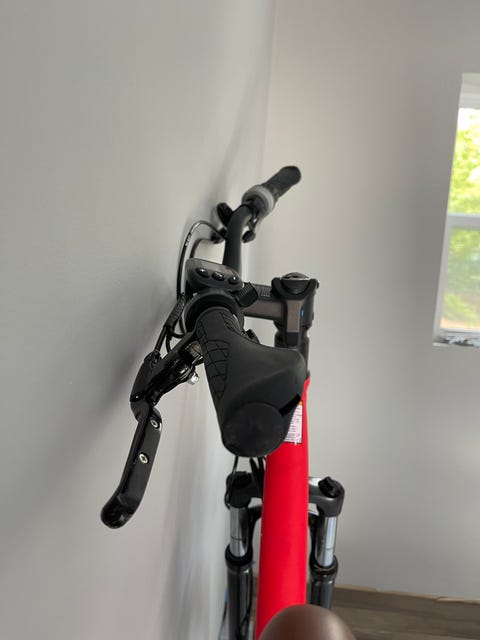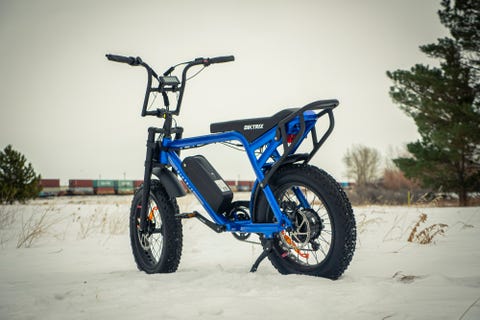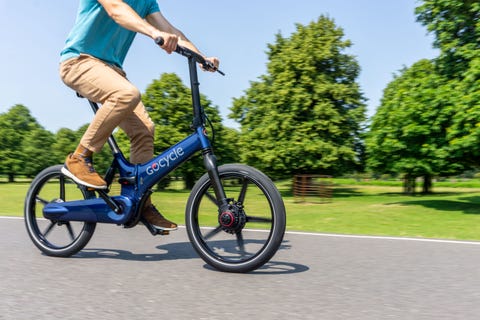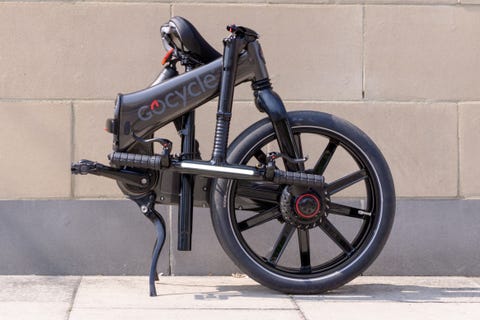If you’ve never ridden an e-bike, it might be easy to miss the appeal. You don’t get the exercise of a regular bike, nor the speed of a motorcycle—or, for that matter, of a 50-cc moped. But e-bikes are sneaky fun. Most of them go at least 20 mph, with some models providing assist to 28 mph. And while that’s not enough to hang with traffic on a two-lane highway, it’s plenty around a local neighborhood or downtown, and the sensation of gliding silently down the road is unexpectedly satisfying. It’s the rush of releasing the brakes on your old BMX and ripping down a big hill, everywhere you go.
“It puts a grin on your face,” says Richard Thorpe, a former McLaren design engineer who founded e-bike manufacturer Gocycle. “People get it. It’s a transformative product. Just this year, I’ve seen loads more on my daily commute.”
Or, as one of our 11 year olds said as she cruised up a hill on a Gocycle, “I’m never going to pedal again!”
(She has since pedaled plenty on her own old-fashioned bike. Up hill. Both ways. Because that’s how we had to do it.)
Since e-bikes are constantly evolving and morphing into new forms, we took some time this summer to test three examples that target decidedly different riders and price points: the Charge Comfort step-through, the Biktrix Moto dirt-bike-in-disguise, and the Gocycle GXi, a carbon-fiber folding bike with an usual feature: two-wheel-drive.
Charge Comfort
The Charge Comfort ($1699) is a step-through city bike that, with the flip of a few levers, can turn itself two-dimensional. The handlebars spin to line up with the frame and the pedals fold up vertically, allowing you to place the bike flat against a wall in your house or garage (or, as we did, flat on a hitch-mounted cargo carrier without worrying about the handlebars scraping the pavement). Great idea, especially if you have multiple bikes.
The Comfort arrives almost fully assembled, with an easy-to-follow printed guide that makes it hard to screw up—the valve stems on the tires even turn green when the air pressure is high enough, in case you don’t have a gauge. Really, all you have to do is install the front tire and tighten a few nuts with the included torque T-handle torque wrench.
A Suntour fork provides about three inches of travel, which is enough to take the edge off of cracked pavement—it’s not like this is a Stumpjumper—and a 6061 aluminum frame helps keep weight down to 51 pounds. This is an e-bike that you can actually pedal without assistance, if need be (range is up to 50 miles, depending on how much you use the motor). It’s also one that you’ll pedal along with the electric assist, because the rear hub motor is only 250 watts. On flat roads, it’ll get the Charge up to its 20-mph limit, but on hills you might need to pedal along to keep things moving. Especially if you’ve loaded up the rear rack to its 44-pound capacity. Our only other critique? Placing the thumb throttle on the left bar feels a little awkward. But that’s good news if you’re a southpaw.
Biktrix Moto
We rode more than 100 miles on the Biktrix Moto ($2499) before it occurred to us to try pedaling. Indeed, with its off-road-moped styling, 750-watt hub motor and low-slung seat, you can forget that the Biktrix is a bike. And once we actually tried riding it like one, we quickly went back to the throttle—with a single speed, nonadjustable seat height and 75 pound weight, the Moto’s pedals are vestigial signifiers of human-powered travel. If you have to use them, something’s gone terribly wrong.
The Moto is available with either 20-inch or 24-inch wheels, accommodating riders from 5’5” to “5’10” plus,” which we assume to mean Tacko Fall. We tested one of the first bikes off the line, and as such the assembly instructions were a bit confusing, in that there weren’t any. Biktrix soon put out a video guide, but in the meantime we’d gotten it all assembled except for the front headlight and fender, so we just started riding. And the Moto is a blast. It’s nominally rated for a 20 mph top speed, but will usually pull to 25 mph before grudgingly throttling back down. The motor feels stronger than 750 watts, an impression supported by the onboard computer’s power-output screen, which can spike at nearly 1000 watts when climbing a hill. Even hauling a 190-pound rider up a steep hill, the Moto never lacks for power, and the battery is good for up to 50 miles of range. The Moto also has a dual-battery option, with a second battery under the seat doubling the range. Maybe you’d need that if you’re a courier riding all day, but otherwise the single battery is plenty.
Other than the front fender, we also never got the front hydraulic brake dialed in. It looked like either the front wheel or the brake rotor was slightly out of true, so the rotor lightly scraped the pads with every rotation. It would probably be an easy fix for a bike shop, but in the DIY spirit we just ignored it and kept riding.
Gocycle GXi
“The key part of what I was doing there,” Richard Thorpe, Gocycle’s CEO says of his time with McLaren, “was working with lightweight structures, composite engineering. For example, when you’re packaging an F1 car, or a Le Mans car, the aerodynamicist shapes it. As engineers we had to go out and fit everything inside.
“You’ve got this outside skin and you have to make it work. There’s no compromise. that’s something I really gained an appreciation for and carried through into Gocycle.”
Thorpe’s e-bike business began as Karbon Kinetics in 2002. In 2009, the Gocycle G1 was introduced and the last 12 years have seen the steady evolution of that first e-bike. The GXi we got to play with in Ann Arbor was introduced in 2019 and featured another carryover from the McLaren days—a premium price ($4799).
Earlier this year, the fourth-generation Gocycle G4 arrived with more enhancements and a base-model price of $3999. (The next step up, the G4i retails $4999, and the premium G4i+ can be yours for $5999). The biggest change is the introduction of the new G4Drive, after two years of development, which replaces the decade-old GX system in the bike we tested. “One of the areas of improvement is low-end start-up torque,” Thorpe says.
The GXi made us do just a touch of work before we could engage the motor and startle the neighborhood walkers as we silently shot by them at 20 mph, which we knew because the Gocycle smartphone app offers all kinds of information, let’s you play with drive modes, and attaches easily to the top of the handlebars. It also connects to the bike with an ease you don’t always find with Bluetooth tech.
The bike is light, around 36 pounds. Charging time is between four and seven hours, and when that’d finished, it’ll give you roughly 50 miles of range, depending on how you’re riding it and how much you want to assist the motor.
What all the models have in common is how exactly you go about assisting that motor. Gocycle’s electric motor powers the front wheel, you’re legs drive the rear, meaning you’ve got a nicely balanced two-wheel drive ride at your disposal.
The other feature that’s helped Gocycle stand out since its first model is that it folds up neat. Really easily. And that’s also Thorpe’s wishes at work. He was living and working in London, riding his conventional bike around town, and he had two stolen. So he wanted something he could fold up and take into the office, or his home. That’s great for city living, but it also makes it easy to load it into the car and drive it across town for a ride. “It’s a product that’s very, very easy to live with,” Thorpe says.
This content is created and maintained by a third party, and imported onto this page to help users provide their email addresses. You may be able to find more information about this and similar content at piano.io


